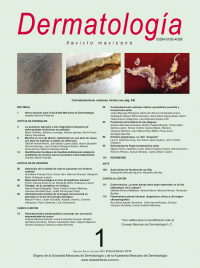Dermatol Rev Mex. 2019 enero-febrero;63(1):90-94.
Leonor Cifuentes-Tang, Iván Darío López-Cadena, Jairo Victoria-Chaparro
Fundación Clínica Infantil Club Noel, Cali, Valle del Cauca, Colombia.
Resumen
La urticaria pigmentosa, también conocida como mastocitosis maculopapular, es el tipo de mastocitosis más común en la edad pediátrica. Se manifiesta con máculas o pápulas de color amarillo-marrón, usualmente localizadas en el tronco y las extremidades con signo de Darier positivo. La cantidad de máculas puede llegar a ser tan numerosa que estos pacientes han sido conocidos con el apelativo de niños “leopardo”. Al considerar las implicaciones diagnósticas y terapéuticas, el objetivo de este artículo es actualizar los aspectos más relevantes de la enfermedad. Se comunica el caso de un niño de dos años de edad con la forma clásica de la enfermedad, con la especial característica de mostrar abundantes lesiones cutáneas; se discute la manifestación clínica, la histopatología y el tratamiento.
PALABRAS CLAVE: Urticaria pigmentosa; mastocitosis; signo de Darier.
Abstract
Urticaria pigmentosa, also known as maculopapular mastocytosis, is the most common type of mastocytosis in the pediatric age. It presents with yellow-brown macules or papules, usually located on the trunk and limbs with a positive Darier sign. The number of maculae can be so numerous that these patients have been known as “leopard” children. Considering the diagnostic and therapeutic implications, the objective of this article is to provide an update of the most relevant aspects of the pathology. We report the case of a 2-year-old child with the classic form of the disease, with the special characteristic of presenting abundant skin lesions; the clinical presentation, histopathology and treatment are discussed.
KEYWORDS: Urticaria pigmentosa; Mastocytosis; Darier’s sign.

